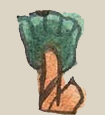cuahuitl (Mdz40r)
This element for tree(s) (cuahuitl) has been carved from the compound sign for the place name, Cuauhtecomatzinco. It is a small and simple tree, with one main trunk, two-toned green foliage at the top, and one severed branch on the viewer's right. The trunk is a terracotta color, and it has two black stripes, one thin and one thick.
Stephanie Wood
Because the compound had several elements, the tree had to be small, but it has all the essential elements for the "cuauh" reading. The black stripes (tlilcuahuitl) are phonetic indicators that this sign is a tree (cuahuitl), something I discovered independently, but which has also been pointed out by Brígida von Mentz ("De árboles, raíces, y locativos en la iconografía del México antiguo," Tlalocan 15, 2008, 216–219).
Stephanie Wood
c. 1541, but by 1553 at the latest
trees, árboles

cuahui(tl), tree(s), https://nahuatl.wired-humanities.org/content/cuahuitl-1
tlilcuahui(tl), black stripe(s), https://nahuatl.wired-humanities.org/content/tlilcuahuitl
Codex Mendoza, folio 40 recto, https://digital.bodleian.ox.ac.uk/objects/2fea788e-2aa2-4f08-b6d9-648c00..., image 90 of 188.
The Bodleian Libraries, University of Oxford, hold the original manuscript, the MS. Arch. Selden. A. 1. This image is published here under the UK Creative Commons, “Attribution-NonCommercial-ShareAlike 3.0 License” (CC-BY-NC-SA 3.0).

